
Poecilia is a genus of fishes in the family Poeciliidae of the order Cyprinodontiformes. These livebearers are native to fresh, brackish and salt water in the Americas, and some species in the genus are euryhaline. A few have adapted to living in waters that contain high levels of toxic hydrogen sulfide and a population of P. mexicana lives in caves.
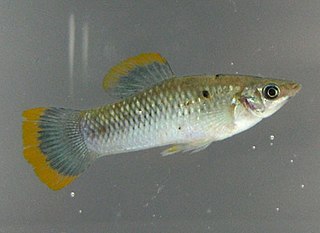
Poecilia sphenops, called the Mexican molly or simply the molly, is a species of poeciliid fish from Central America. It was once understood as a widespread species with numerous local variants ranging from Mexico to Venezuela, but these variants are today considered distinct species belonging to the P. sphenops complex and P. sphenops itself as being native to Mexico, Guatemala, and Honduras. Due in part to its popularity as an aquarium fish, the species has been introduced outside of its native range, but many records may in fact refer to P. mexicana or other species from the complex. P. sphenops has been crossbred with other mollies, notably P. latipinna and P. velifera, to produce fancy mollies for the ornamental fish trade.
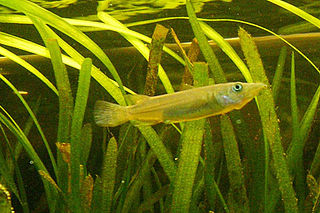
Nomorhamphus is a southeast Asian genus of viviparous halfbeaks from streams, rivers and lakes in Sulawesi (Indonesia) and the Philippines. They are all viviparous, producing small clutches of around a dozen fry about 10 to 15 mm long at birth. Females are generally larger than the males. In the largest species, such as Nomorhamphus liemi, the females typically reach about 10 centimetres (3.9 in) in length, whereas the males reach about 6–7 cm (2.4–2.8 in) in length. Males are also more brightly coloured than the females. Compared with many other halfbeaks, the lower mandible, or beak, is relatively short, on females in particular barely protruding beyond the length of the upper mandible. The males of some species have short, straight beaks, but those of others have short beaks that curve downwards forming a shape often compared to a goatee beard by aquarists. N. aenigma is unique within Nomorhamphus because of its lack of lower jaw elongation.

The Anabantoidei are a suborder of anabantiform ray-finned freshwater fish distinguished by their possession of a lung-like labyrinth organ, which enables them to breathe air. The fish in the Anabantoidei suborder are known as anabantoids or labyrinth fish, or colloquially as gouramies. Some labyrinth fish are important food fish, and many others, such as the Siamese fighting fish and paradise fish, are popular as aquarium fish.

Heterandria formosa is a species of livebearing fish within the family Poeciliidae. This is the same family that includes familiar aquarium fishes such as guppies and mollies. Heterandria formosa is not as commonly kept in aquaria as these species. Despite the common name "least killifish", it belongs to the family Poeciliidae and not to one of the killifish families. H. formosa is one of the smallest fish species; the 1991 Baensch Aquarium Atlas listed it as the 7th smallest fish in the world, and as of 2006 it remains the smallest fish species found in North America.
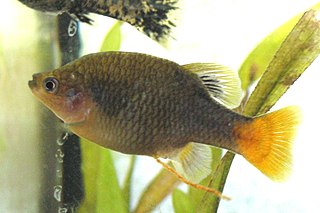
The redtail splitfin or redtail goodeid is a species of goodeid fish from the family Goodeidae and subfamily Goodeinae. Like other members of Goodeinae, the redtail splitfin is native to Mexico and a livebearer. However, the goodeid mating system differs in several ways from the more common livebearing fish from the family Poeciliidae that includes guppies and swordtails. While no goodeid species is a very popular aquarium fish, the redtail splitfin is one of the most popular. Only the male has the red-orange tail for which it is named. Its specific name honours the collector of the type, Gustav Eisen (1847–1940) who was Curator of Marine Invertebrates at the California Academy of Sciences in San Francisco, California.

The guppy, also known as millionfish or the rainbow fish, is one of the world's most widely distributed tropical fish and one of the most popular freshwater aquarium fish species. It is a member of the family Poeciliidae and, like almost all American members of the family, is live-bearing. Guppies originate from northeast South America, but have been introduced to many environments and are now found all over the world. They are highly adaptable and thrive in many different environmental and ecological conditions. Male guppies, which are smaller than females, have ornamental caudal and dorsal fins. Wild guppies generally feed on a variety of food sources, including benthic algae and aquatic insect larvae. Guppies are used as a model organism in the fields of ecology, evolution, and behavioural studies.

Neoheterandria elegans or Tiger Teddy is a small live-bearing fish within the family Poeciliidae. This is the same family that includes familiar aquarium fishes such as guppies and swordtails, although Neoheterandria elegans is not nearly as popular as an aquarium fish. The fish is found in the Truando River in Colombia. Males grow to 2.0 centimetres (0.79 in) and females grow to 2.5 centimetres (0.98 in). The front half of the fish is mostly silver but the rear has alternating gold and black vertical bars.

Platy is a common name of freshwater fish in the genus Xiphophorus that lack a "sword" at the bottom of their tails. Both species are livebearers, similar to other fish of the family Poeciliidae, such as the guppy and molly. Platies are native to the east coast of Central America and southern Mexico.
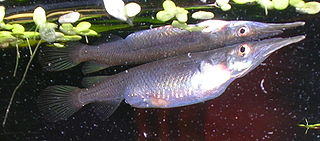
Zenarchopteridae, the viviparous halfbeaks, is a family of ray-finned fishes in the order Beloniformes. The Zenarchopteridae exhibit strong sexual dimorphism, practicing internal fertilisation, and in some cases ovoviviparous or viviparous. The members in the family are mainly found in fresh and brackish water of tropical Asia and New Guinea, but the genus Zenarchopterus also includes marine species from the Indo-Pacific. Several, such as the wrestling halfbeak, have become commonly traded aquarium fish.

Poeciliinae is a subfamily of killifish from the family Poeciliidae which contains species from the Americas which are collectively known as the livebearers because many, but not all, of the species within the subfamily are ovoviviparous.

Alfaro cultratus, the knife livebearer, is a species of tropical freshwater fish from the family Poeciliidae. It hails from Central America and is often kept in home aquaria.

Limia islai, also known as the tiger limia, is a species of fish within the family Poeciliidae. This species is one of several Limia that are endemic to Lake Miragoâne, Haiti.

Limia melanogaster, the black-bellied or blue limia, is a poeciliid fish from Jamaica. It inhabits fast-flowing streams. It is a rare livebearer in modern fishkeeping.

Poecilia kykesis, also known as the Usumacinta molly, Petén molly, spiketail molly, or swordtail molly, is a poeciliid fish species native to the fresh and brackish waters of Mexico, Guatemala, and Belize. It belongs to the sailfin molly clade, with males exhibiting an enlarged dorsal fin. The species has a notably controversial naming history, with the former name, Poecilia petenensis, now referring to a short-finned molly species. It is a livebearer sometimes kept in aquaria.
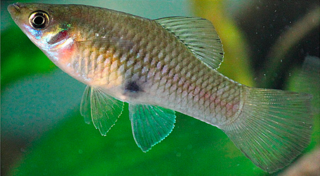
Phallichthys amates, the merry widow or merry widow livebearer, is a livebearer fish from Central America, the largest and most widespread in its genus. Two subspecies range from Guatemala to Panama. Distinguishing features include the dark dorsal fin edge, a stripe through the eye, and an oversized male copulatory organ (gonopodium).
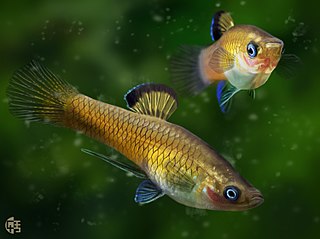
Phallichthys tico, the dwarf merry widow, is a livebearer fish from Central America. It lives in turbid, stagnant waters, often among aquatic plants, and feeds mainly on plant matter. It is sometimes kept in aquaria.

Poecilia vivipara, sometimes called the southern molly, is a small euryhaline livebearer fish distributed along the Atlantic coast of South America. It is most frequently found in standing brackish water. It has been introduced outside its native range to control mosquito populations and is occasionally kept in home aquariums.

Cnesterodon decemmaculatus, the ten spotted live-bearer, is a species of poeciliid native to Argentina and Uruguay.
























